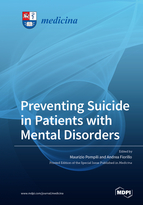Preventing Suicide in Patients with Mental Disorders
A special issue of Medicina (ISSN 1648-9144).
Deadline for manuscript submissions: closed (31 August 2019) | Viewed by 89765
Special Issue Editors
Interests: suicide and suicide prevention; public health; well-being; youth mental health
Special Issues, Collections and Topics in MDPI journals
Interests: clinical psychiatry; epidemiology; social psychiatry; early intervention in mental health; promotion of mental health
Special Issues, Collections and Topics in MDPI journals
Special Issue Information
Dear Colleagues,
Suicide is a multi-factorial, highly prevalent clinical condition; it is estimated that every 30 seconds a person worldwide commits suicide. Moreover, it represents the second cause of death in adolescents, and it is becoming a major health problem, which requires the development and adoption of appropriate preventive strategies.
Suicide is a complex phenomenon that is now considered understood as a neurodevelopmental condition encompassing childhood experiences as well as proximal conditions such as mental disorders and adverse life events. Individuals in crisis may face overwhelming psychological pain, which in some cases may overcome the threshold of each unique individual for whom suicide is considered the best option to deal with such pain. However, many socio-demographic, personal, or temperamental variables have been investigated for their causal association with suicide risk, but to date no single factor has clearly demonstrated an association with suicide. The mental disorders most frequently associated with suicide risk include bipolar disorders and major unipolar depression, substance use disorders and schizophrenia. However, anxiety, personality, eating, and trauma-related disorders, as well as organic mental disorders, also contribute to suicidal risk. Moreover, in modern society, the presence of social uncertainty, the changes in family models, the development of social media, and the loss of face-to-face interaction can have an impact on suicide risk, particularly in the younger generation.
We are pleased to invite you and your co-workers to contribute to this Special Issue with original research reports, reviews, or meta-analyses on the topics of suicide and mental disorders, the social and personal burden of suicide, and the possible preventive strategies to be implemented for reducing suicidal risk for each mental disorder considered. All mental disorders as well as mental health problems associated with an increased risk of suicide can be considered for publication in this Special Issue.
Prof. Maurizio Pompili
Prof. Andrea Fiorillo
Guest Editors
Manuscript Submission Information
Manuscripts should be submitted online at www.mdpi.com by registering and logging in to this website. Once you are registered, click here to go to the submission form. Manuscripts can be submitted until the deadline. All submissions that pass pre-check are peer-reviewed. Accepted papers will be published continuously in the journal (as soon as accepted) and will be listed together on the special issue website. Research articles, review articles as well as short communications are invited. For planned papers, a title and short abstract (about 100 words) can be sent to the Editorial Office for announcement on this website.
Submitted manuscripts should not have been published previously, nor be under consideration for publication elsewhere (except conference proceedings papers). All manuscripts are thoroughly refereed through a single-blind peer-review process. A guide for authors and other relevant information for submission of manuscripts is available on the Instructions for Authors page. Medicina is an international peer-reviewed open access monthly journal published by MDPI.
Please visit the Instructions for Authors page before submitting a manuscript. The Article Processing Charge (APC) for publication in this open access journal is 1800 CHF (Swiss Francs). Submitted papers should be well formatted and use good English. Authors may use MDPI's English editing service prior to publication or during author revisions.
Keywords
- Suicide
- Non-suicidal self-injury
- Suicidal behaviours
- Mental disorders
- Suicidality
- Survivors
- Hopelessness








